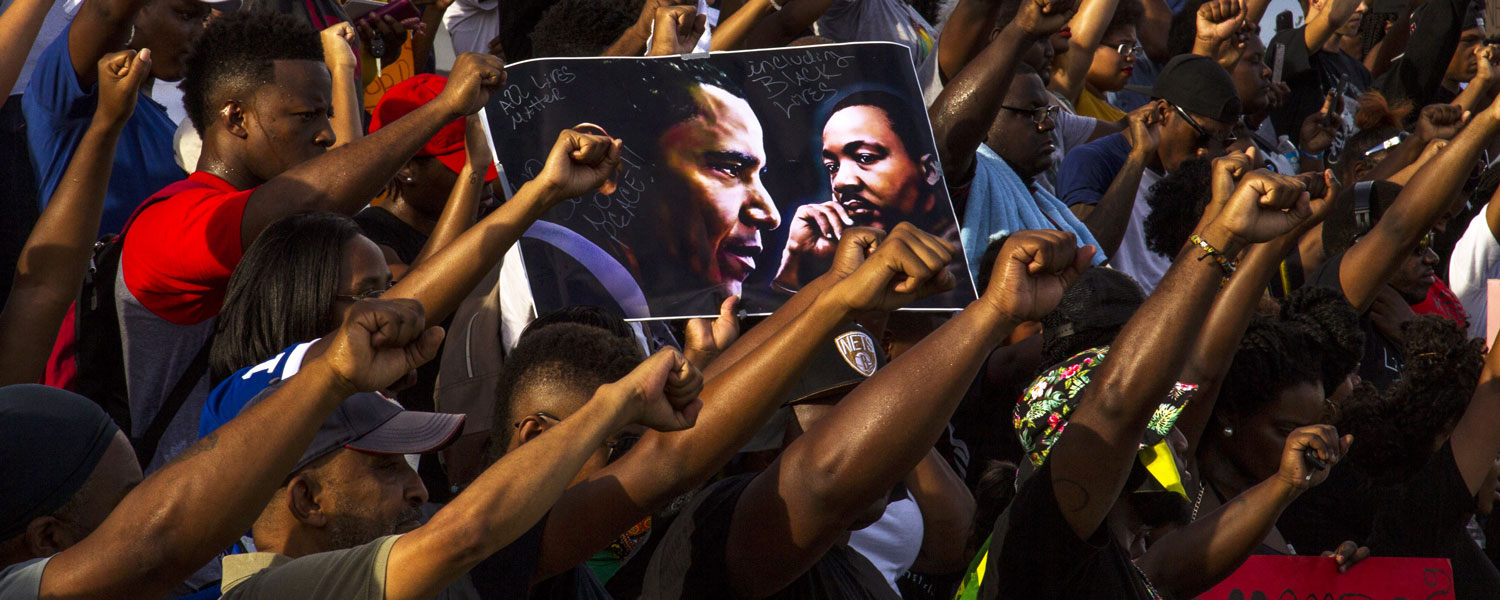
<p><em>Demonstrators gather after marching at the Louisiana Capitol to protest the shooting of Alton Sterling on July 9, 2016 in Baton Rouge, Louisiana. Photo by Mark Wallheiser/Getty Images</em></p>
During the protest-filled 1960s, one way you could tell somebody was a serious black community leader was that they were not afraid to "tell it like it is." This usually meant that they were not afraid to make an insightful analysis or scathing indictment of the racial status quo. They did so even though prior history had shown that by boldly speaking out, they could literally risk life and limb.
In the wake of the civil rights and black power movements, things have changed dramatically, and today’s black activists are directly addressing the new challenges of our time. While structural inequalities affect the entire black community, the dominant narrative does not and cannot capture the immense diversity of black Americans today. The time has come to rethink and reframe the narrative of anti-black racism to better illustrate its disparate impact on all black Americans.
Progress—and setbacks—over the past 50 years
The black community has achieved major educational and economic gains over the past half century. Between 1994 and 2012, the number of black women and men entering college increased 21 percent and 1 percent respectively, outpacing white women (6 percent) and men (no increase). This dramatic trend occurred despite persistent inequalities and harsh disciplinary policies in K–12 education that disproportionately affect students of color.
But black Americans still attend college (69 percent of women and 57 percent of men) at lower rates than white Americans (72 percent of women and 62 percent of men).
In addition, between 1979 and 2014, black Americans saw the largest increase in median income in their group’s history. But during the last 15 years, the wealth gap between America’s richest and poorest neighborhoods has sharply increased, disproportionally affecting predominately black neighborhoods.
The policy victories of the civil rights and black power movements made these educational and economic gains possible. However, many black Americans are still left behind in schools and neighborhoods that are underresourced and overpoliced. Our schools are still highly racially segregated despite integration initiatives that were catalyzed by the Brown v. Board of Education ruling and reached their height in the 1980s.
Today’s biggest issues: Criminal justice and gun violence
Progress for some has not been progress for all. The US criminal justice system still disproportionately affects black people and other people of color. One in three black men experience incarceration in their lifetime, and black women are among the fastest-growing prison populations. Black Americans are still far more likely to be stopped, arrested, convicted, and incur harsh sentences than white Americans.
Even though US gun violence kills more whites than blacks, gun violence disproportionately affects the black community. Black Americans are twice as likely as white Americans to die from a gunshot.
Although this disparity has improved over the last 20 years (in 1993, black Americans were three times as likely to die from a gunshot), much work still needs to be done. While it is imperative to confront the institutional racism that leads to police shootings of black people, research shows policymakers and community activists also need to engage with efforts to reduce the high black homicide rate through curtailing easy gun availability in the black community.
What anti-black racism looks like today
Unfortunately, it appears that what Harlon Dalton wrote 20 years ago in his book, Racial Healing: Confronting the Fear Between Blacks and Whites, still largely holds true when it comes to the American black community in 2016:
Our first order of business is to rethink and retell how racism has affected our lives. There is a stock story that we tend to trot out when the occasion demands but it is badly out of date. It fails to take account of the many twists and turns in our fate since slavery. It does not acknowledge the great variety within our own community along virtually every dimension—class, color, racial consciousness, life experiences, lifestyle, and livelihood. It fails to explain why some blacks are doing quite well, even as others are doing poorly.
A quick, cursory examination of recent data supports Dalton's points quite well.
The reality of disparate progress has created immense diversity in lived experience within the black community that cannot be captured by the existing narrative. Black men—from Harvard professors to hoodie-clad teenagers—are treated with often lethal suspicion. Black women—transgender and cisgender, walking and driving—are murdered at the hands of both civilians and police. These shared experiences of anti-black racism create narratives that are intertwined but certainly not interchangeable.
Policymakers need to focus on a massive overhaul of the criminal justice system and efforts to address the availability of guns in this country in general—and the black community in particular.
Evidence-based violence prevention needs funding; one example of this is the data-driven Brady Campaign’s study of a Chicago-area gun shop that sold guns used in 1 in 12 crimes in the city between 2009 and 2013, part of the organization’s larger effort to target “bad-apple” gun dealers. Prison reforms need to reinvest money into communities, diversion programs, and alternatives to incarceration.
To tell it like it is when it comes to anti-black racism in this country, policy advances need to reflect the interconnected nature of all these crises. And they must be comprehensive, working toward solutions that touch on the criminal justice system, lack of educational opportunity, the guns on our streets, and beyond. The result will be a safer, more just society.
Dr. James Jones is a professor of world religions and African studies at Manhattanville College.
Let’s build a future where everyone, everywhere has the opportunity and power to thrive
Urban is more determined than ever to partner with changemakers to unlock opportunities that give people across the country a fair shot at reaching their fullest potential. Invest in Urban to power this type of work.